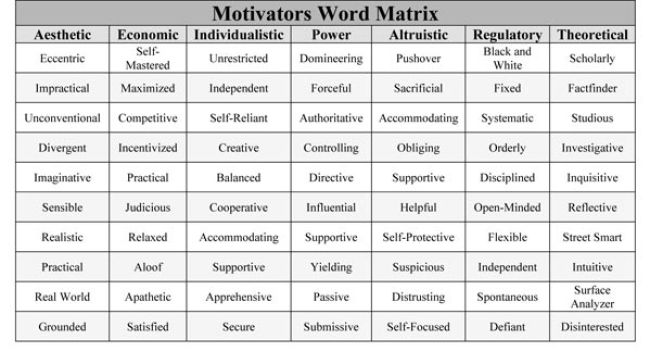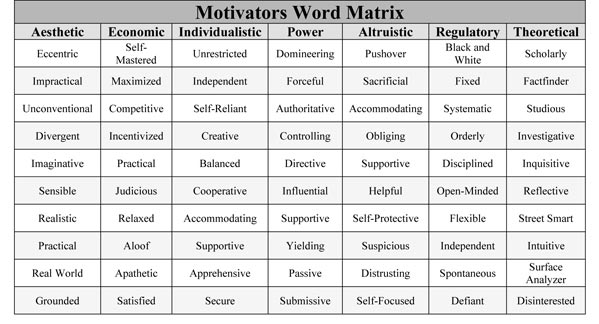
Motivators: To Improve Performance, Understand What Drives Your Behavior
So far in this six-part series, we’ve talked about learning styles and the DISC assessment. In this third installment, we’re going to dive into motivators, including an assessment you can take to determine your own personal motivators.
Greater self-awareness typically leads to greater personal and professional success. Self-aware people understand what their motivators are and recognize, among other things, that their motivators influence their behaviors and actions. People who understand their motivators are more likely to pursue the right opportunities for the right reasons and use their motivators to drive behaviors aligned with their desired outcomes, both of which make them more successful.
Below is a brief overview of seven dimensions of motivation based on the work of psychologists Eduard Spranger and Gordon Allport. Knowledge of these dimensions will help you identify your motivators and understand your unique behavioral drivers. After you read the overview, we also will take a look at how you can best apply your motivators – once you’ve established what they are – to achieve greater success. Keep in mind that most people are motivated in part by each of the seven dimensions, but every individual is unique as to how much or how little they are motivated by each one.
The Seven Dimensions of Motivation
1. Aesthetic
The aesthetic dimension ranges from grounded (using pragmatic and tangible approaches that bring about concrete and reliable results) to eccentric (achieving equilibrium and harmony between the world around you and yourself). Based on outcomes of the Motivators assessment offered through the Incident Prevention Institute (see https://assessmyteam.com/motivators/ for more), average scores are characterized by words like “imaginative” and “sensible.”
2. Economic
The economic dimension ranges from satisfied (taking up less competitive approaches and being content with what you have) to self-mastered (focusing on self-interest, economic gains and achieving real-world return on efforts). Average scores are characterized by words like “practical” and “judicious.”
3. Individualistic
The individualistic dimension ranges from secure (not seeking the limelight, keeping ideas to yourself and doing little self-promotion) to unrestricted (expressing autonomy and freedom from others’ ideas and protocols). Average scores are characterized by words like “balanced” and “cooperative.”
4. Power
The power dimension ranges from submissive (supporting others’ efforts) to domineering (directing and controlling others). Average scores are characterized by words like “directive” and “influential.”
5. Altruistic
The altruistic dimension ranges from self-focused (tending to personal wants and needs and being suspicious of others) to pushover (helping others at personal cost). Average scores are characterized by words like “supportive” and “helpful.”
6. Regulatory
The regulatory dimension ranges from defiant (challenging others’ restrictive ideas) to black and white (following rules, procedures and boundaries). Average scores are characterized by words like “disciplined” and “open-minded.”
7. Theoretical
The theoretical dimension ranges from disinterested (relying on natural instincts and past experiences) to scholarly (seeking new knowledge, skills and abilities). Average scores are characterized by words like “inquisitive” and “reflective.”
Application of Motivators
The essential point of understanding here is that your motivators influence your behavior. Subsequently, if you know your motivators, you can identify and control biases and tendencies, which will lead to improved behaviors that will result in higher levels of performance. Consider these three practical scenarios as examples.
Scenario 1: A person who is highly unrestricted, self-focused, and highly submissive or domineering in the power dimension may struggle to contribute in collaborative environments. However, if this person understands their motivators and is willing to adapt to the needs of their team, they can become a better contributor.
Scenario 2: Someone who is extraordinarily defiant and scholarly might gravitate toward high risk tolerance, which would make them a safety concern. On the other hand, if this same person understands their motivators, they can adjust their risk tolerance and work safely, all while exploring and suggesting new approaches that may improve everyone’s safety.
Scenario 3: Think about people with low scores in the economic dimension who also have very high scores in the altruistic dimension. Their focus on helping others with little regard for return on investment could lead to decisions detrimental to themselves, their teams and their organization. But if they understand their motivators and are willing to make changes, they will be less likely to be taken advantage of.
No Motivator is an Island
It is important to understand that motivators influence each other and are not the sole factor in your decisions and actions; that’s why I hope you will read this entire series and take each of the related assessments.
At a high level, think about how the following factors combine and contribute to decisions and behaviors: an individual who scored highly in dominance on the DISC assessment (see https://incident-prevention.com/blog/behavioral-profiles-use-disc-to-predict-and-adapt for more on this assessment) and earned low altruistic, extremely low regulatory, very high power, high economic and average individualistic scores in the motivators assessment. How would they be perceived by others, and what behaviors would they likely exhibit? Note: This will be a topic of discussion in the webinar associated with this article.
Conclusion
We have talked about learning styles, the DISC assessment and motivators so far in this series. Soon we will discuss emotional intelligence and decision making. A lot goes into our thoughts, decisions and actions. I cannot stress enough that the more we understand ourselves, the better we can become at making intentional, informed decisions and relating and adapting to others. Motivators are critical to determining how we behave.
About the Author: David McPeak, CUSP, CET, CHST, CSP, CSSM, is the director of professional development for Utility Business Media’s Incident Prevention Institute (https://ip-institute.com). He has extensive experience and expertise in leadership, human performance, safety and operations. McPeak is passionate about personal and professional development and believes that intrapersonal and interpersonal skills are key to success. He also is an advanced certified practitioner in DISC, emotional intelligence, the Hartman Value Profile, learning styles and motivators.
About Frontline Fundamentals: Frontline Fundamentals topics are derived from the Incident Prevention Institute’s popular Frontline training program (https://frontlineutilityleader.com). Frontline covers critical knowledge, skills and abilities for utility leaders and aligns with the Certified Utility Safety Professional exam blueprint.
*****
A Simple Self-Assessment
Medical professionals use MRIs as a tool to diagnose what they can’t otherwise see. Just like an MRI, a motivators assessment is a tool that can show you what you can’t see, what you don’t know and areas that you need to focus on. If you’d like to try a simple self-assessment, circle the word in each column of the matrix below that you think best describes you in that dimension. I also recommend asking others what word they think best describes you in each dimension and then taking the motivators assessment (see https://assessmyteam.com/motivators/) to validate your self-assessment.

*****
Webinar on Motivators
July 8, 2020, at 3:30 p.m. Eastern
Visit https://frontlineutilityleader.com for more information.

